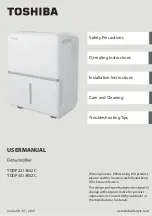
19
6.5.6 Alarm & Service Mode
1. Alarm & Service Mode is active when the controller
is in Display Mode. It is not active in Program Mode,
Setup Mode, or Test Mode.
2. Local alarm consists of a blinking alarm LED and an
alarm message display.
3. Alarm messages have priority over Service
messages. Service messages have priority over
Display Messages.
4. After an alarm condition has been corrected, if:
a. Alarm is “self-clearing” then,
i. The alarm LED stops blinking (LED on); the
alarm message continues to be displayed.
ii. The alarm reset button must be depressed to
clear the alarm LED (LED off) and the alarm
message.
b. Alarm must be manually reset, then:
i. The alarm LED continues to blink and the
alarm message continues to be displayed.
ii. The alarm reset button must be depressed
to:
1. Clear the alarm LED (LED off)
2. Clear the alarm message and
3. Restart the dryer cycle.
5. When an alarm condition has not been corrected
and the “alarm reset” button is pressed, the alarm
will not clear except as follows:
a. The alarm conditions will clear for 5 seconds,
then reappear if the alarm condition persists, this
applies to the following alarms:
i. Heater: High Inlet Temperature.
ii. Heater: Low Temperature
iii. Humidity Sensor: High Humidity Alarm
iv. Humidity Sensor: Under-Range or Over-
Range Alarm
v. Dew Point Sensor: High Dew Point Alarm
vi. Dew Point Sensor: Under-Range or Over-
Range Alarm
6. There are three alarms for each tower that are
triggered by the tower pressure switches. These
alarms can occur in any operating mode (Manual,
Fixed, Energy Management, or Dew Point Demand
Cycle).
Following is a brief description of each alarm.
a. Left or Right tower, drying, low pressure
i. Drying tower pressure switch is open during
the drying cycle.
b. Left or Right tower, regenerating, high pressure
i. Regenerating tower pressure switch is closed
while purge valve is open (after an initial time
delay).
c. Left or Right tower, regenerating, low pressure
i. Regenerating tower pressure switch is open
at the end of the regenerating cycle.
d. On alarm condition, the blower and heater are
de-energize, the cycle sequence is stopped, a
local alarm is displayed and the common alarm
relay is de-energized.
e. These alarms are self-clearing.
7. Heater High Inlet Temperature
a. Model sizes 3200, 3600 and 4300 are equipped
with a temperature switch located in the piping
between the blower and heater.
b. If during the Heat Cycle this temperature switch
opens, indicating a rise in temperature above
the factory setting (refer to Electrical Schematic
drawings at the back of this manual for set point),
an alarm is activated.
c. On alarm condition, the blower and heater are
de-energized, the cycle sequence is stopped, a
local alarm is displayed and the common alarm
relay is de-energized.
d. This alarm must be manually reset.
8. The dryer is equipped with RTD temperature sensors.
There are out of range alarms for each.
a. The standard left tower, right tower, and heater
RTDs (RTD1, RTD2, RTD3) are scaled from
-20°F(-28°C) to 890°F (477°C), “Out of Range”
conditions are as follows:
i. Over-range - temperature above 850°F
(454°C)
ii. Under-range - temperature below -20°F
(-28°C)
iii. Note: The controller will annunciate a “Heater
Overtemperature” alarm in lieu of an “Over
Range” alarm when the heater sensor is
disconnected.
b. The Energy Management RTD4 is scaled from
-20°F(-28°C) to 429°F(220°C), “Out of Range”
conditions are as follows:
i. Over-range - temperatures above 400°F
(204°C)
ii. Under-range - temperatures below -20°F (-
28°C)
c. On alarm condition, a local alarm is displayed and
the common alarm relay is de-energized.
d. Over-range and Under-range alarms are self-
clearing.
Summary of Contents for HBP Series
Page 43: ...43...
















































